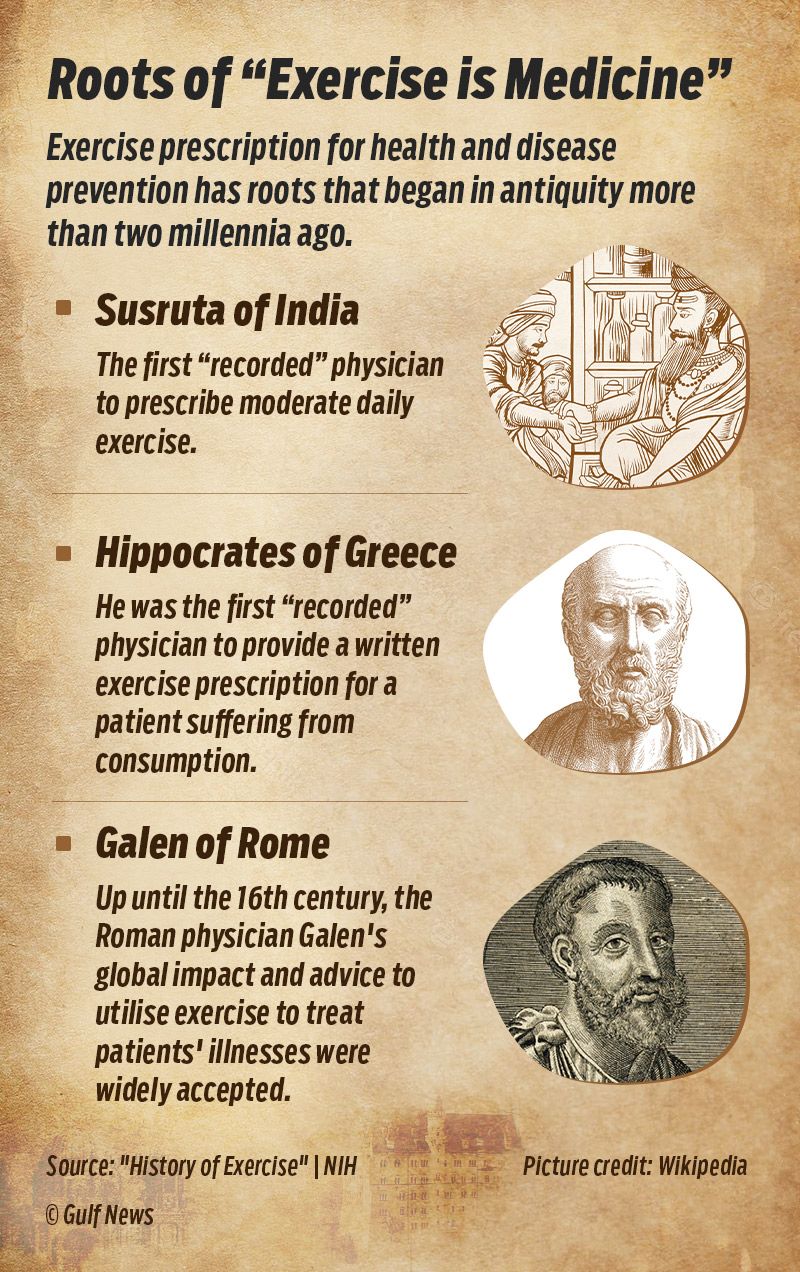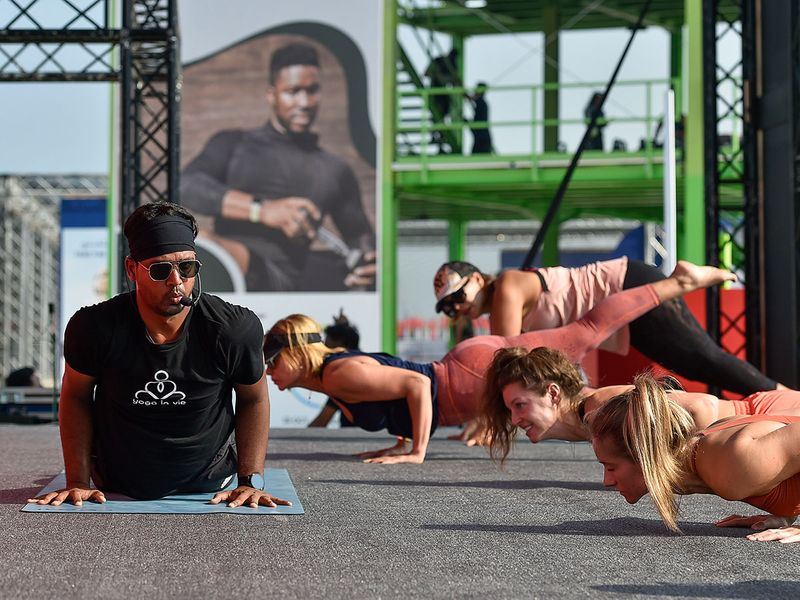_resources1_16a4505bdfb_medium.jpg)
Regular physical activity is not merely about looking better. It's about feeling better and living longer. Exercise is a powerful prescription. It turns out that a range of health problems can be prevented by leading a healthy lifestyle and regular exercise.
Some of benefits from exercise: preventing health issues, increasing strength, enhancing energy levels, reducing stress, maintaining a healthy weight, and controlling your appetite. It's your faithful companion on the quest for a healthy life, a resilient physique and keeping the so-called "lifestyle diseases" at bay.
Exercise is medicine: Where did this wild idea come from?
It's actually as old as time. Ancient doctors including Susruta of India, Hippocrates of Greece and Galen of Rome had all prescribed exercise as part of medical therapy.

In terms of recorded prescription, a treatise on exercise made by Susruta of ancient India — the first recorded physician to prescribe moderate daily exercise — goes back to 600 BC.
Susruta (or Sushruta) advocated exercise to restore the equilibria between the “doshas”: Vata, Pitta, and Kapha. Vata (space and air) governs movement, pitta (fire and water) regulates metabolism, and kapha (earth and water) manages assimilation in the body.
These three categories, called "doshas", are named (a) "Vata" (space and air, which governs movement), (b) pitta (fire and water, which regulates metabolism), and (c) kapha (earth and water, which manages assimilation in the body).
These are dynamic energies, constantly responding to a person's thoughts, emotions, environment and actions.
Today’s physiologists collectively recognise Susruta’s wisdom, and acknowledge that he was remarkably modern with his ancient concepts.
Greek physician Hippocrates (450 BC to 380 BC), known as the "Father of Medicine" (that's where the "Hippocratic Oath" for doctors comes from), left a written prescription for exercise for a patient suffering from "consumption".
His writings, collected in Corpus Hippocraticum, provide a wealth of information on biomedical methodology and offer one of the first reflective codes of professional ethics. Galen of Rome (born 129 CE), who exercised a dominant influence on medical theory and practice, also prescribed exercise as medicine.
Fast forward to the present.

Renowned Harvard evolutionary biologist Dr. Daniel E. Lieberman, celebrated for his best-selling titles like "Exercise: The Science of Physical Activity," "Rest and Health," "The Molecule of More," and "The Story of the Human Body," presents a thought-provoking viewpoint.
He highlights how our evolutionary past naturally inclined us toward physical activity, as our forebears were involved in tasks such as farming, hunting, and gathering.
“We evolved to be physically active… working in the fields, hunting, gathering, but now in a world where only 50 per cent of Americans ever exercise and the rest of the world is headed our way.”

In fact, women who have 150 minutes of physical activity a week have a 30 to 50 per cent lower breast cancer risks than people who are sedentary. And yet for some reason, this is not a well-known fact.
His cited statistical data from numerous studies which show that cancers, depression and anxiety can be attributed to less physical activity.

Dr. Lieberman stated: “In fact, women who have 150 minutes of physical activity a week have a 30 to 50 per cent lower breast cancer risks than people who are sedentary. And yet for some reason, this is not a well-known fact."
"We have epidemiological data, we have mechanistic data, we understand how and why it works. Yet how often do you hear about cancer prevention (benefits of exercise)?"
"We often hear about treating cancer, which is all important. If I get cancer I would like it treated too, thank you very much. But why don’t we spend more energy and activity and have more education on how to prevent cancer in the first place?"
"And it’s crazy, the problem is that we spend on our medical budget on prevention and yet 75 per cent of the time, the disease is a preventable disease. It’s a completely backward system."
Exercise cuts down insulin levels. The lower the insulin (the more active a person is), the lower the level of stored energy in the body, and the less food for illnesses like cancer, said Dr Liberman.
“When you eat food, insulin levels go up, because its job is to store that energy. And when you exercise, insulin levels go down,.because you then want to use that energy. When cells get more energy, they’re more prone to go out of control, basically.
"And inflammation is caused by getting you to store so much fat in your cells that those fat cells start to swell. And when they start to swell, like anything, they start to rupture, and get damaged. And that damage attracts the immune system and the immune system gets turned on and that causes inflammation,” he explained.
Benefits of exercise

Any physical activity that we perform on a repetitive basis for relaxing our body and taking away all the mental stress is what is generally referred to as execise. When you do it on a daily basis, you become fit both physically and mentally.
On the other hand, being "sedentary" (not exercising daily) can make a person susceptible to diseases of all sorts, a growing body of evidence shows. So just like eating food daily, we must also exercise daily.
What evidence supports the exercise-is-medicine claim?
It’s not a claim. It’s a medical fact.
Physical activity serves as potent medicine. Not only does it serve as a valuable took in managing one’s body weight and regulating appetite, but also plays a pivotal role in maintaining a well-balanced and holistic way of life.
Where's the proof?
If you look around, you'll find plenty of proof. There’s an enormous amount of research pointing to the efficacy of exercise — when prescribed as a medical treatment — as being effective at preventing and treating most of the major chronic diseases, including cancer,cardiovascular diseases, arthritis, osteoporosis, back pain, diabetes, depression and other mental illnesses — as well as falls in the elderly.

Exercise is medicine, and health care providers should aspire to educate and assist their patients in becoming effective independent exercisers so that together we can improve the health and wellbeing of our communities.
Dozens of publications (12 related to all-cause mortality, five related to cardiovascular disease; and one article contained two outcomes: both all-cause death and cardiovascular events) included in a “meta-analysis” published in 2022, pointed to remarkable evidence.
Some are mentioned below:
Study 1: Journal of Sport and Health Science
One study simply counted the daily steps taken by thousands of participants and then calculated their cardiovascular disease (CVD) risk. The research led by Mingxin Sheng explored specifically the statistical link — or relative risk (RR) — between daily step count and cardiovascular events.

Study results were published in December 2021 in the Journal of Sport and Health Science entitled "The relationships between step count and all-cause mortality and cardiovascular events: A dose-response meta-analysis", in which researchers found compelling evidence of the efficacy of exercise in preventing early death. What researchers found:
- For every 500 steps increased per day (based on five previous studies with 14,670 participants, with 1082 cases), the risk of CVD was 6% lower.
- Four studies (with 14,080 participants with 848 cases) were also included in the dose–response analysis of daily steps and risk of CVD, which results in combined RR for high risk vs. low risk was 0.41.
- Compared to the first group or “quartile” — who averaged 3,742 steps/day — the second group/quartile (5,500 steps/day) had a 17.74 per cent lower CVD risk.
- The third group/quartile — who walked 9,500 steps/day — had a 42.94 per cent lower CVD risk than the first group/quartile.
Study 2: Scandinavian Journal of Medicine & Science in Sports
In a significant study published in 2015 in the Scandinavian Journal of Medicine & Science in Sports, researchers led by B.K. Pedersen and B. Saltin presented a compelling case for prescribing exercise as a form of therapy for a wide range of chronic diseases.
Their study, titled "Exercise as Medicine - Evidence for Prescribing Exercise as Therapy in 26 Different Chronic Diseases," delved into the scientific underpinnings supporting the use of exercise to combat a diverse array of health conditions.
This comprehensive study covered a wide range of diseases, including psychiatric disorders like depression, anxiety, and schizophrenia, neurological conditions such as dementia, Parkinson's, and multiple sclerosis, as well as metabolic diseases like obesity and diabetes.
Cardiovascular conditions like hypertension and coronary heart disease, pulmonary diseases such as asthma and chronic obstructive pulmonary disease, musculoskeletal disorders like osteoarthritis, and even cancer were examined.
This groundbreaking study signifies a transformative shift in healthcare, recognizing exercise as a fundamental part of medical intervention, offering invaluable guidance to healthcare professionals and individuals seeking to enhance their well-being through the prescription of exercise.
Study 3: British Medical Journal
A cohort study, published in the British Medical Journal in July 2020, examined the relationship between recommended physical activity and mortality using a nationally representative sample of US adults. The study used data from the National Health Interview Survey (1997-2014) with linkage to the National Death Index records until December 31, 2015.
150
minutes of moderate-intensity of aerobic activity per week dubbed "sufficient"Sufficient physical activity, as defined by the study, involved adults engaging in at least 150 minutes of moderate-intensity aerobic activity and two days of muscle-strengthening exercise per week. The study included 479,856 adult participants aged 18 and older, with a median follow-up period of 8.75 years.
During this period, 59,819 adults passed away due to various causes.
479,856
Number of participants aged 18 and older covered in the cohort study published in the BMJ on benefits of exerciseThe study found that adults who adhered to the 2018 US physical activity guidelines, engaging in recommended levels of leisure time aerobic and muscle-strengthening activities, experienced a significantly reduced risk of all-cause and cause-specific mortality. Those who participated in either aerobic or muscle-strengthening activities individually also showed a lower risk.
Remarkably, the most substantial survival benefits were observed in individuals who engaged in both activities, with similar patterns observed for cause-specific mortality related to cardiovascular disease, cancer, and chronic lower respiratory tract diseases. These findings underscore the substantial benefits of adhering to recommended physical activity guidelines.

Study 4: How exercise fights cancer
Exercise is a potent weapon in the battle against cancer, bolstering the body's natural defenses. Physical activity triggers the release of immune-boosting myokines, empowering your immune system to identify and combat cancer cells. This synergy of exercise and immunotherapy offers promising potential in cancer treatment. A robust immune system excels at recognizing and addressing potential cancer threats, backed by Cancer Research UK's findings linking physical activity to cancer prevention.
For cancer risk reduction, experts recommend daily exercise: an hour of moderate activity or 30 minutes of vigorous exercise. Notably, exercise is particularly beneficial for cancer patients, countering muscle and nerve damage caused by treatments. Stretching and yoga aid muscle preservation.
The researchers concluded that an active lifestyle and optimal weight support a robust immune system, marking exercise as a pivotal element in cancer prevention and management. Whether for risk reduction or during treatment, physical activity contributes significantly to the fight against cancer.
These studies, among others, show that engaging in exercise acts as a proactive measure in averting health complications, enhancing physical resilience, elevating vitality, and aiding in stress reduction.
More physicians and oncology specialists are integrating exercise into cancer care.
He added: Appropriately-prescribed exercise has been proven to improve Cardio Respiratory Fitness (CRF), and CRF is as strong of a predictor for premature mortality, as other risk factors routinely addressed in medicine, such as cigarette smoking, hypertension, hypercholesterolemia, and type 2 diabetes."
Dr Kampert, who is also the director of Exercise Medicine for Cleveland Clinic’s Endocrinology & Metabolism Institute, said: "Exercise is medicine, and health care providers should aspire to educate and assist their patients in becoming effective independent exercisers so that together we can improve the health and wellbeing of our communities."
Dr Kampert recommends brief physical activity assessment and counseling as an effective, and cost-efficient means to increase physical activity, and presents a unique opportunity to encourage lifestyle-based strategies for reducing cardiovascular risk.

Where to start?
He advises patients to meet their doctor to know where they are before trying to have them progress in order to assess the individual patient’s level of baseline fitness.
A good starting point to turn exercise into medicine, said Dr Kampert, is by having exercise assessments for body composition, strength and cardiorespiratory fitness completed by an exercise professional like an exercise physiologist.
This provides a baseline to monitor progress and to determine the dose titration of the exercise prescription. You would not prescribe antihypertensive medication without initially assessing a patient's blood pressure, and regular monitoring of blood pressure for changes. So the same applies to prescribing exercise.











